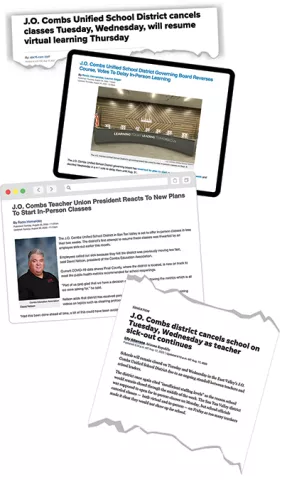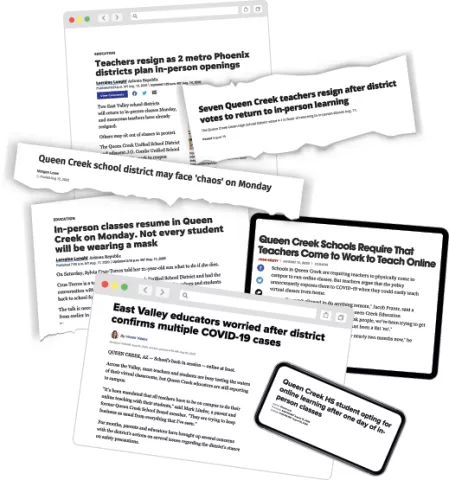
Arizona teacher Dave Nelson was stunned when school board members in the J.O. Combs Unified School District voted 3-2 in early August to order educators and students back into schools on August 17, 2020, against the recommendation of state health officials.
Teachers didn’t have adequate PPE or sanitizing supplies. They had no idea how many students would be in their classrooms. Many educators in this small, rural district have medical health concerns, or their spouses, children or parents have health concerns, and they fear Arizona is nowhere near having its COVID-19 pandemic under control.
The state was reporting about 900 new COVID-19 cases a day as the number of cases in the state exceeded 200,000 and deaths near 4,600. Statewide, the percentage of COVID-19 test-takers who test positive was about 10 percent, higher than the national average of 6.5 percent and much higher than its neighbors in New Mexico (2.5 percent) and Utah (8.6 percent.)
“Our belief is that it’s not safe. These are minimal standards to reduce the risk of exposure,” said Nelson, of the state metrics around reopening.
With help from the Arizona Education Association, Combs teachers met, talked into the night over Zoom, and decided they simply couldn’t risk the lives of their family members and students by rushing into in-person education.
That week, they began informing administrators that they wouldn’t be at work on Monday, August 17—instead they’d be using medical leave or expanded family and medical leave provided by the Families First Coronavirus Response Act (FFCRA).
With a “sickout” in place, district officials had no choice but to cancel classes on Monday.
And Tuesday. And on Wednesday. In the face of continued, united opposition by educators, on August 19, the J.O. Combs school board members voted 4-1 to reverse their previous decision to open schools. Instead, educators would provide virtual learning to students until at least August 27, when school officials will re-evaluate health and safety indicators. At the time this publication went to print, the school board met once more and delayed in-person learning to September 8, 2020.
What’s next isn’t clear. Nelson, who also is president of the AEA-affiliated J.O. Combs Education Association, hopes that educators, parents and administrators can work together on a plan that relies on remote learning until it’s safer for students and educators to return to classrooms.

“There are legitimate challenges with remote learning, but I would rather deal with those than the fear of who’s sick and who’s on a ventilator,” says Nelson.
Get the Details Right First
Although J.O. Combs school board members said they were reopening schools because parents wanted schools open, many parents said they appreciated how teachers are taking a stand for community safety.
Parent Lila Gonzalez has two students, a kindergarten and seventh grader. “I didn’t even know [reopening in-person] was on the table!” she says.
Gonzalez, a nursing student who previously taught, says she appreciates teachers’ questions about safety protocols. For example, how is lunch going to work? Where are the sanitizing stations and how often will they be used? “Every little detail matters here,” she says. “I would like for them to hold off a little bit, at least until September, to figure this out.”
She adds, “This is not about teachers not wanting to go back. They want to be safe—safe for themselves, safe for their families, and most of all, their students. They want clear guidelines on keeping people safe.”
The bottom line is, “We shouldn’t be open if we haven’t met the state guidelines from the health department,” mother of three Heidi Swinney told the Arizona Republic.
Lives Are at Stake
Although schools are closed, teachers don’t feel like they’ve won anything, says Nelson. This is farthest thing from a win-win situation. With schools closed, students aren’t learning. But if schools open, people could die.
“It’s a s*@! sandwich,” he says. “The question is which end we bite.”
On Facebook and other social media, Nelson and his colleagues have been attacked as anti-American, as lazy, as unwilling to work, and worst of all, as uncaring about kids. During the August 19 board meeting, Nelson other educators were screamed at and verbally abused by community members, with one parent coughing on them as they walked by to speak during the meeting.
“It’s disheartening. It’s terrifying. And I don’t hate the other side. I don’t think most of us do. We just believe that we’re not ready. We’re not asking to stop anything, we’re asking to slow down and prepare better.”
Yes, many students are suffering while out of school, but educators will deal with those effects, he promises. “We have ways to deal with the social toll. We don’t have ways to deal with this virus,” says Nelson.
“I’m not happy about any of this. There’s nothing to dance in the streets about here,” he says. “We didn’t draw this line or take a stand to win something. We fought this because we truly believe lives are at stake.
“If you put one person in harm’s way, and you can avoid it? Then avoid it!”
Teachers Resign in East Valley District
Educators faced a similar dilemma in Queen Creek Unified School District when classes resumed in person on August 17.
“The numbers we were seeing for the COVID infection rate back in May was alarming, as was what was happening in schools that were trying to open,” says Queen Creek Education Association President Jacob Frantz. “Everything we know about COVID says that classrooms are ideal conditions for it to spread, and our district leadership doesn’t seem to appreciate that.”
Despite the resignation of several teachers, including Frantz, the identification of positive COVID cases on campus, and the health benchmarks not being met according to the Arizona Department of Health Services school reopening benchmarks released last month, the District has continued to put educators and students in harm’s way.
Frantz’ advice for educators: “Stay on top of your school board elections.”
